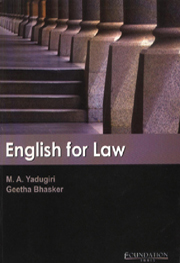Book contents
- Frontmatter
- Preface
- Contents
- A Note to the Student
- Notes to the Teacher
- 1 Nature of Law
- 2 Crimes and Civil Wrongs
- 3 Command of Language in the Profession of the Law
- 4 Plain Language and the Law
- 5 The Indian Constitution
- 6 The Impact of Technology on the Practice of Law
- 7 The International Court of Justice
- 8 Application of Precedents
- 9 Statutory Interpretation
- 10 Legal Reasoning
- 11 Plaints and Writs
- 12 Judgment
- 13 Of Defamation
- 14 Consumer Protection (Amendment) Act, 1993
- 15 The Information Technology Act, 2000
- 16 Universal Declaration of Human Rights
- Answer Key
2 - Crimes and Civil Wrongs
Published online by Cambridge University Press: 26 October 2011
- Frontmatter
- Preface
- Contents
- A Note to the Student
- Notes to the Teacher
- 1 Nature of Law
- 2 Crimes and Civil Wrongs
- 3 Command of Language in the Profession of the Law
- 4 Plain Language and the Law
- 5 The Indian Constitution
- 6 The Impact of Technology on the Practice of Law
- 7 The International Court of Justice
- 8 Application of Precedents
- 9 Statutory Interpretation
- 10 Legal Reasoning
- 11 Plaints and Writs
- 12 Judgment
- 13 Of Defamation
- 14 Consumer Protection (Amendment) Act, 1993
- 15 The Information Technology Act, 2000
- 16 Universal Declaration of Human Rights
- Answer Key
Summary
The law is divided into two great branches, the criminal and the civil, and of these much the greater is the civil. Since the nature of the division must be grasped at the outset, I shall try to give a simple explanation of it.
The distinction between a crime and a civil wrong, though capable of giving rise to some difficult legal problems, is in essence quite simple. The first thing to understand is that the distinction does not reside in the nature of the wrongful act itself. This can be proved quite simply by pointing out that the same act may be both a crime and a civil wrong. Occasionally at a bus station there is someone who makes a living by looking after people's impedimenta while they are shopping. If I entrust my bag to such a person, and he runs off with it, he commits the crime of theft and also two civil wrongs – the tort of conversion and a breach of contract with me to keep the bag safe. The result is that two sorts of legal proceedings can be taken against him: a prosecution for the crime, and a civil action for the tort and for the breach of contract. (Of course, the plaintiff in the latter action will not get damages twice over merely because he has two causes of action: he will get only one set of damages.)
- Type
- Chapter
- Information
- English for Law , pp. 26 - 59Publisher: Foundation BooksPrint publication year: 2005



